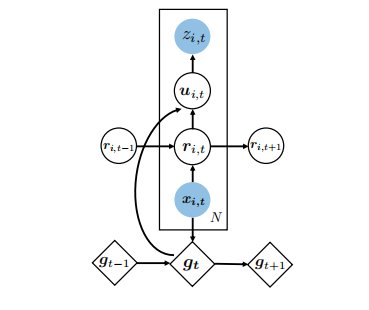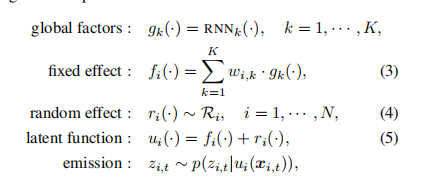Deep Factors是一种global-local组合的框架预测模型,根据论文里给出的实验结果,Deep Factors的总体性能要优于现阶段主流的区间预测算法DeepAR和MQ-RNN。
优势:1.速度更快;2.学习参数少;3.global-local组合比seq2seq结构更加灵活高效。
Deep Factors一般有三种结构形式,本文复现的是第一种,即运用RNN求取sigma值。


class DeepFactor(nn.Module):def __init__(self, input_size, global_nlayers, global_hidden_size, n_global_factors):super(DeepFactor, self).__init__()self.lstm = nn.LSTM(input_size, global_hidden_size, global_nlayers, \bias=True, batch_first=True)self.factor = nn.Linear(global_hidden_size, n_global_factors)def forward(self, X):num_ts, num_features = X.shapeX = X.unsqueeze(1)_, (h, c) = self.lstm(X)ht = h[-1, :, :] # num_ts, global factorsht = F.relu(ht)gt = htreturn gt.view(num_ts, -1)class Noise(nn.Module):def __init__(self, input_size, noise_nlayers, noise_hidden_size):super(Noise, self).__init__()self.lstm = nn.LSTM(input_size, noise_hidden_size,noise_nlayers, bias=True, batch_first=True)self.affine = nn.Linear(noise_hidden_size, 1)def forward(self, X):num_ts, num_features = X.shapeX = X.unsqueeze(1)_, (h, c) = self.lstm(X)ht = h[-1, :, :] # num_ts, global factorsht = F.relu(ht)sigma_t = self.affine(ht)sigma_t = torch.log(1 + torch.exp(sigma_t))return sigma_t.view(-1, 1)class DFRNN(nn.Module):def __init__(self, input_size, noise_nlayers, noise_hidden_size,global_nlayers, global_hidden_size, n_global_factors):super(DFRNN, self).__init__()self.noise = Noise(input_size, noise_hidden_size, noise_nlayers)self.global_factor = DeepFactor(input_size, global_nlayers,global_hidden_size, n_global_factors)self.embed = nn.Linear(global_hidden_size, n_global_factors)def forward(self, X,):if isinstance(X, type(np.empty(2))):X = torch.from_numpy(X).float()num_ts, num_periods, num_features = X.size()mu = []sigma = []for t in range(num_periods):gt = self.global_factor(X[:, t, :])ft = self.embed(gt)ft = ft.sum(dim=1).view(-1, 1)sigma_t = self.noise(X[:, t, :])mu.append(ft)sigma.append(sigma_t)mu = torch.cat(mu, dim=1).view(num_ts, num_periods)sigma = torch.cat(sigma, dim=1).view(num_ts, num_periods) + 1e-6return mu, sigma

